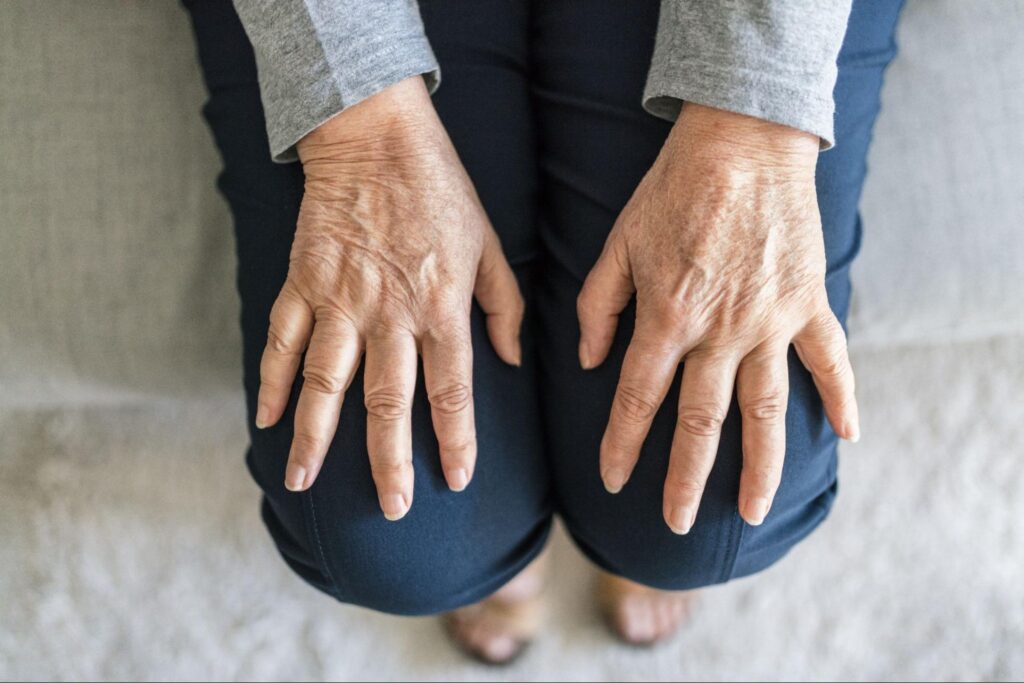Hand pain can disrupt daily tasks, such as typing, cooking, gripping objects, or performing fine motor activities. Two common causes are carpal tunnel syndrome (CTS) and hand arthritis. While their symptoms can overlap, these conditions have distinct causes and characteristics.
Determining whether symptoms are related to CTS or arthritis is crucial for effective treatment. Misdiagnosis may lead to methods that fail to address the root problem, prolonging discomfort or limiting movement. At-risk groups include office workers with extensive typing, athletes with repetitive hand strain, pregnant individuals experiencing hormonal changes, and older adults with age-related joint wear.
The primary difference lies in the source: CTS involves compression of a specific wrist nerve, whereas arthritis results from joint inflammation or wear and tear. Recognizing these distinctions may empower individuals to take informed steps toward relief.
In this article, we’ll explore CTS and hand arthritis by examining their symptoms, causes, and diagnostic methods. You’ll also learn about how diagnostic ultrasound provides a patient-friendly option for identifying CTS and how carpal tunnel release with ultrasound guidance (CTR-US) may address nerve compression. By the end, you’ll understand how to differentiate these conditions and explore steps toward better hand health and comfort.
What Is Carpal Tunnel Syndrome (CTS)?
Carpal tunnel syndrome (CTS) is a condition that results from compression of the median nerve, which runs from the forearm to the hand through a space called the carpal tunnel. The median nerve provides sensation to the thumb, index, middle, and part of the ring fingers, as well as motor function to certain thumb muscles.
CTS often causes burning, tingling, numbness, or pain in the affected fingers. Initially intermittent, these symptoms may worsen over time, leading to hand weakness or difficulty gripping objects. Symptoms often intensify at night or after prolonged repetitive activity, prompting some individuals to shake or flick their hands for relief. If untreated, CTS may result in chronic nerve compression, reduced grip strength, and impaired hand coordination.
Risk factors for CTS include repetitive wrist movements, such as typing or using hand tools, which can narrow the carpal tunnel and increase nerve pressure. Pregnancy-related swelling, diabetes, rheumatoid arthritis, and hypothyroidism may also heighten susceptibility. Anatomical differences, like a smaller carpal tunnel, further increase the likelihood of developing CTS. According to the National Institute of Neurological Disorders and Stroke (NINDS), identifying CTS early may help prevent worsening nerve compression.
Identifying tasks or habits that aggravate CTS is important for relief. Frequent wrist bending or extension, forceful gripping, or vibration tasks can exacerbate symptoms. Addressing these issues early and seeking medical evaluation may help minimize nerve compression and prevent complications.
Understanding Hand Arthritis

Hand arthritis involves inflammation in the joints of the hand and wrist, causing pain, stiffness, and reduced functionality that can make everyday tasks challenging. Two common types are osteoarthritis and rheumatoid arthritis, each with distinct causes and progression.
Osteoarthritis, a “wear-and-tear” condition, occurs as cartilage—the cushioning tissue between bones—breaks down over time, leading to bone-on-bone contact, pain, stiffness, and sometimes swelling. It typically affects older adults due to aging and prolonged joint use, but can also impact younger individuals after injuries or repetitive strain.
Rheumatoid arthritis is an autoimmune disorder where the immune system mistakenly attacks the joint lining, causing pain, swelling, and damage if untreated. Unlike osteoarthritis, rheumatoid arthritis usually affects the same joints on both sides of the body and may occur at any age, often progressing through flare-ups and remission periods.
Key symptoms of hand arthritis include deep, aching joint pain, swelling, stiffness—especially after rest—and reduced grip strength. In advanced stages, visible changes like bony enlargements (for example, at the thumb base or knuckles) may occur, restricting movement and making tasks like opening jars or buttoning clothes difficult.
While arthritis does not compress nerves like CTS, it may be equally debilitating through its impact on joint function. Early identification of arthritis symptoms is vital to slow progression and maintain hand mobility. The Arthritis Foundation suggests various strategies to help reduce strain on arthritic joints, including specialized exercises and ergonomic tools.
Treatment for hand arthritis focuses on symptom management, function preservation, and prevention of further damage. This may include physical or occupational therapy, anti-inflammatory medications, or supportive devices like braces or splints.
Key Differences Between CTS and Hand Arthritis
While carpal tunnel syndrome and hand arthritis may share some overlapping symptoms, they are fundamentally different conditions with distinct causes, symptom patterns, and functional impacts.
This is not intended to be a diagnostic aid or medical advice. Please contact your healthcare professional if you believe any of this may apply to you.
1. Location and Type of Pain
- CTS: Pain or tingling is typically concentrated in the thumb, index, middle, and part of the ring finger—the area served by the median nerve. The pain may feel like burning or “pins and needles.”
- Arthritis: Pain is primarily localized in the joints, such as the knuckles, thumb base, or wrist. This discomfort is often a deep, aching pain, sometimes accompanied by joint swelling or stiffness.
2. Symptom Patterns
- CTS: Symptoms often worsen at night or after repetitive hand movements, causing numbness or tingling in the fingers. Individuals commonly shake their hands to relieve the sensation. Left untreated, CTS may lead to prolonged nerve compression and weakened grip strength.
- Arthritis: Symptoms are more pronounced after periods of rest, especially in the morning, resulting in joint stiffness. Mild activity may temporarily relieve arthritis-related stiffness, though excessive use can worsen inflammation.
3. Cause and Structural Source
- CTS: Results from compression of the median nerve as it passes through the carpal tunnel in the wrist. Factors such as swelling, repetitive wrist movements, or certain wrist positions reduce the available space, increasing nerve pressure.
- Arthritis: Originates from joint inflammation or cartilage degeneration. Osteoarthritis develops due to cartilage wear, while rheumatoid arthritis stems from an autoimmune attack on the joint lining.
4. Progression Over Time
- CTS: Symptoms may escalate if untreated, transitioning from intermittent numbness to persistent tingling, hand weakness, or muscle atrophy at the thumb base.
- Arthritis: Progression can be gradual or variable. Osteoarthritis often develops over years, whereas rheumatoid arthritis can cycle through flare-ups and remission. Advanced stages may include joint deformities.
5. Impact on Daily Activities
- CTS: Tasks requiring detailed hand movements—like typing, writing, or gripping small objects—become increasingly difficult as nerve compression worsens.
- Arthritis: Everyday activities, such as bending fingers, may become painful due to joint stiffness and swelling.
Take A Symptom Survey
Diagnosing Hand Pain: The Importance of Accurate Evaluation
Accurately diagnosing the cause of hand pain is vital for finding an effective course of action. Whether the issue is CTS or arthritis, a thorough evaluation by a healthcare professional may confirm the underlying cause.
The diagnostic process* often begins with a detailed discussion of symptoms, including when they occur and whether there is numbness, tingling, swelling, stiffness, or deep pain. A physical examination may follow, assessing grip strength, joint flexibility, and other indicators. Specific manual tests often include:
- For CTS: Tinel’s sign and Phalen’s maneuver can help identify nerve compression.
- For Arthritis: Swelling, tenderness, or bony enlargements may suggest inflammation or joint changes.
* Different healthcare providers may approach diagnosis differently. The following is only intended as an example of what some providers may consider.
Diagnostic Ultrasound for CTS
One efficient, patient-friendly way to evaluate CTS involves diagnostic ultrasound. This imaging method provides real-time views of internal structures. Placing the ultrasound probe over the wrist creates an immediate on-screen image, allowing providers to examine the median nerve for swelling or compression.
Unlike certain diagnostic methods that require waiting for results, ultrasound offers instant feedback. It is painless, non-invasive, and radiation-free, making it more comfortable for patients. By comparing images from both wrists, healthcare professionals can pinpoint structural differences and confirm CTS.1
Arthritis Diagnosis
Ultrasound may also detect joint swelling or early cartilage degeneration, aiding in arthritis evaluation. In some cases, further assessments—like blood tests—may detect inflammatory markers if rheumatoid arthritis is suspected. Basic X-rays might be used to check for more advanced joint damage. Taken together, these tools help ensure an accurate diagnosis and a more targeted treatment plan.
Treating Carpal Tunnel Syndrome: Exploring Minimally Invasive Options
Managing CTS centers on alleviating pressure on the median nerve. Treatment approaches vary depending on severity, from conservative measures to advanced procedures.
Non-Invasive Strategies for Early Stages
For mild or moderate CTS, treatment may begin with non-invasive steps. Wrist splints worn at night can help keep wrists in a neutral position, reducing nerve compression. Adjusting daily habits—such as workstation reconfiguration or periodic hand stretches—may also offer relief. Corticosteroid injections may reduce localized swelling for short-term symptom control.
Advanced Treatment: Carpal Tunnel Release with Ultrasound Guidance (CTR-US)
If symptoms persist or progress, a technique called carpal tunnel release (CTR) can be recommended to address pressure on the nerve. While traditional CTR may involve a larger incision in the palm, carpal tunnel release with ultrasound guidance (CTR-US) is a technique that may be offered in the office and appeal to those seeking a minimally invasive approach.
CTR-US is typically performed under local anesthesia.2-5 Real-time ultrasound imaging helps precisely identify the transverse carpal ligament, enhancing accuracy. A small incision is used to divide the ligament, enlarging the tunnel space and decompressing the nerve. Many individuals may return to light daily activities within days, often experiencing less discomfort than with traditional methods.2-4
Please consult with your healthcare professional to discuss the risks and benefits of this procedure to determine if it is right for you. See below for important safety information.
Recovery and Post-Treatment Care
Follow-up care is key for a smooth recovery. Gentle hand exercises may be recommended to restore grip strength and range of motion, particularly if nerve compression lasted a long time. Each patient’s recovery timeline can differ, so discussing expectations with a healthcare provider is essential.
Addressing CTS early—whether through lifestyle adjustments, splinting, or CTR-US—may help preserve hand function. Consulting a healthcare professional experienced in these techniques ensures a tailored approach that aligns with individual symptoms, lifestyle, and treatment goals.
Managing Hand Arthritis: Treatment Considerations

When managing hand arthritis, the aim is to reduce pain, maintain function, and slow joint damage. This may involve:
This is not intended to be a diagnostic aid or medical advice. Please contact your healthcare professional if you believe any of this may apply to you and to see the proper treatment plan.
Physical and Occupational Therapy
Therapy programs can improve joint flexibility and functionality. Physical therapists often recommend gentle exercises to enhance range of motion, while occupational therapists can suggest ways to protect joints during daily tasks.
Medications for Symptom Relief
Over-the-counter pain relievers or anti-inflammatory medications may help with mild cases. Corticosteroid injections can address localized inflammation in a specific joint. Individuals with rheumatoid arthritis may need specialized medications to manage autoimmune responses.
Lifestyle Adjustments
Small changes to daily habits, such as using ergonomically designed tools, maintaining a healthy weight, or adopting assistive devices (like jar openers), may reduce strain. Low-impact exercises, like swimming or walking, can support joint mobility.
Joint Protection and Support
Splints or braces may stabilize painful joints, helping limit movement that aggravates inflammation. Tools with wider grips or padded handles can also help. Activities in warm water, such as aqua therapy, may soothe stiff joints.
Surgical Interventions for Advanced Cases
In cases where arthritis significantly impairs daily life and conservative treatments no longer help, surgical options like joint fusion or replacement might be considered. Surgery is typically reserved for advanced joint damage.
Balancing Activity and Rest
Moderate movement helps maintain flexibility, while too much strain can worsen symptoms. A healthcare provider can recommend a balanced level of activity that supports joint health without exacerbating pain.
An individualized approach combining symptom relief, joint support, and regular follow-up may help those with hand arthritis maintain their daily routines and quality of life.
Preventative Tips for Hand Health
Practicing healthy habits may reduce the likelihood of developing CTS or arthritis, as well as help manage existing conditions:
- Focus on Ergonomics: Keep wrists neutral and supported during tasks. Align keyboards and use properly adjusted desk heights.
- Take Regular Breaks: Pause frequent or repetitive tasks briefly to ease tension. Use short breaks to stretch fingers and wrists.
- Strengthen and Stretch Your Hands: Simple exercises, like squeezing a stress ball or rotating wrists, may help build resilience.
- Maintain a Healthy Lifestyle: Balanced nutrition and regular exercise can support overall health, including joints and nerves.
- Act Early on Symptoms: Ignoring early signs of stiffness, numbness, or tingling may lead to worsening problems. Prompt evaluation may prevent complications.
- Use Protective Gear: For sports or high-impact tasks, wear braces or padded gloves to cushion wrists and stabilize joints.
- Avoid Overuse: Alternate tasks that strain your hands, and rely on tools to share the workload.
Get A Free Screening
Finding Relief and Improving Hand Health
Carpal tunnel syndrome (CTS) and hand arthritis are two common yet distinct conditions that affect the hands and wrists. CTS often involves tingling, numbness, or weakness from compression of the median nerve, while arthritis causes deep, aching pain originating from joint inflammation or wear. Recognizing their unique characteristics may enable individuals to seek the right treatment.
Preventative measures—like ergonomic adjustments, stretching, and protective gear—may reduce the risk of developing either condition or help alleviate existing symptoms. Early detection is crucial for preserving hand functionality. For CTS, diagnostic ultrasound offers a patient-friendly way to evaluate nerve compression, and carpal tunnel release with ultrasound guidance (CTR-US) may address moderate to severe cases in a minimally invasive approach. Arthritis management often includes symptom relief, lifestyle changes, and, in some instances, medications or surgical options.
Taking the first step—whether by consulting a healthcare professional, scheduling an evaluation, or exploring treatment options—may lead to improved comfort and daily function. Don’t let hand pain limit your activities; seek guidance to restore flexibility, strength, and ease to your hands so you can keep doing what you enjoy.
MP04197rA




